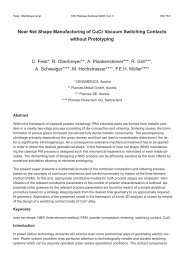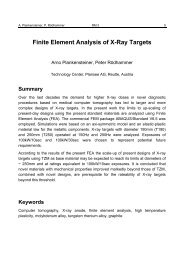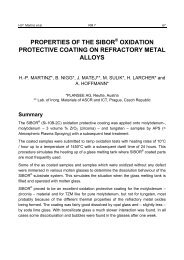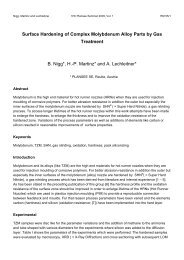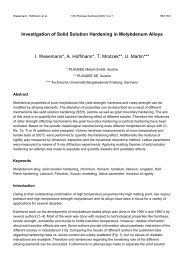Glastechnik Glass Technology - Plansee
Glastechnik Glass Technology - Plansee
Glastechnik Glass Technology - Plansee
You also want an ePaper? Increase the reach of your titles
YUMPU automatically turns print PDFs into web optimized ePapers that Google loves.
Beispiel einer Wannenverkleidung bestehend aus Frontplatte und U-Kanal, rechts zusätzlich mit L-Profil und SIBOR ® beschichteten Bolzen<br />
Example of a throat reinforcement consisting of a front plate and U-channel, on the right additionally with L-plate and SIBOR ® coated pins<br />
Da diese Bauteile noch vor der Befüllung mit Glas in die kalte<br />
Glaswanne eingebaut werden, muss die Oxidation des Molybdäns<br />
durch eine SIBOR ® -Beschichtung solange verhindert<br />
werden, bis der Bereich vollkommen durch die <strong>Glass</strong>chmelze<br />
bedeckt und geschützt wird. Neben der Verlängerung der<br />
Wannenreise trägt dies auch zu einer Verbesserung der Glasqualität<br />
bei, da sich keine unerwünschten Korrosionsprodukte<br />
der feuerfesten Blöcke in der <strong>Glass</strong>chmelze bilden.<br />
PLANSEE liefert folgende auf die jeweilige Glaswanne angepassten<br />
Glaswannenverkleidungen:<br />
- Doghouse<br />
- Bubbler<br />
- Wall<br />
- Durchflussrohre durch den Wall<br />
- Durchfluss<br />
- Umgebung der <strong>Glass</strong>chmelzelektroden<br />
- Andere korrosionskritische Bereiche der Glaswanne nach<br />
Bedarf des Kunden<br />
Zusätzlich stellt PLANSEE auch Ausfluss- und Glasverteilungssysteme<br />
aus langen gesinterten Molybdän-Rohren her,<br />
die zum Teil elektrisch beheizt werden (Corning Patent).<br />
Eine weitere Möglichkeit zur Verbesserung der Korrosionsbeständigkeit<br />
der feuerfesten Refraktärblöcke ist deren Verstärkung<br />
mit Molybdän-Komponenten. Bei diesem durch die<br />
Firma Refel in Italien patentierten Verfahren werden Molybdän-Profile<br />
von PLANSEE in die feuerfesten Blöcke eingegossen,<br />
um diese dadurch während der Aufheizphase der<br />
Glaswanne vor Oxidation zu schützen.<br />
Blasdüsensteinverkleidung<br />
Bubbler reinforcement<br />
Since these components are installed in a cold glass tank<br />
before the firing up process and the glass filling starts, it is<br />
necessary to protect the molybdenum from oxidation with<br />
SIBOR ® coating until it is completely immersed in and protected<br />
by the glass melt. Besides the increase of the service<br />
life, the glass tank reinforcements also improve the glass<br />
melt quality as they reduce the unwanted corrosion products<br />
of the refractory bricks.<br />
PLANSEE supplies the following glass tank reinforcements,<br />
which are modified to fit each individual glass tank:<br />
- Doghouse<br />
- Bubble maker<br />
- Cross wall<br />
- Flow pipes inserted into the wall<br />
- Throat channel<br />
- Surrounding area of the glass melting electrodes<br />
- Other corrosion critical areas of a glass tank according to<br />
customer demand<br />
PLANSEE also manufactures glass distribution and outflow<br />
systems out of long sintered molybdenum tubes, which are<br />
sometimes electrically heated (Corning patent).<br />
A further possibility to increase the corrosion resistance of<br />
refractory bricks is offered by the use of molybdenum-reinforced<br />
bricks. This patented solution from the Italian company<br />
Refel uses molybdenum profiles, manufactured by<br />
PLANSEE, which are cast into the refractory bricks to protect<br />
them from oxidation during the heating up process.<br />
17




